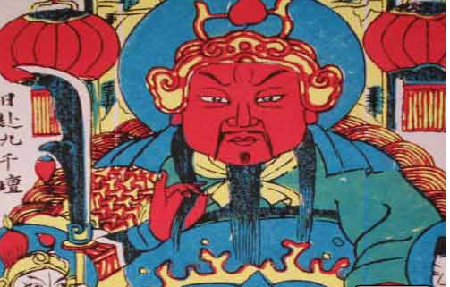|

In rural China, hanging New Year pictures is a must during the Chinese New Year. Among the many distinctive New Year paintings all over China, the woodprint painting genre from Wuqiang County, noted as one of China's seven major New Year painting genres, has enjoyed a long history, diversified styles and widespread reputation. The other six are from: Taohuawu, Jiangsu;Yangliuqing,Tianjin; Mianzhu, Sichuan; Yangjiabu, Shandong; Zhuxianzhen, Henan; andFoshan, Guangdong.
Mainly prevalent in North China, the Wuqiang New Year Woodprint got its name because it is mainly produced in Wuqiang County, Hebei Province. The overprint woodblock technique usually includes three steps; painting, carving, and printing. The subjects usually include opera stories, folk stories, fashion, festivals, marriages, moppets, beautiful things, flowers, and landscapes.
History
The Wuqiang New Year Woodprint emerged 700 years ago, around the end of the Song Dynasty (960-1279) and the beginning of theYuan Dynasty(1271-1368). It peaked during the Ming (1368-1644) and Qing (1644-1911) dynasties.
Folk artists first painted each picture and later the woodblock was fixed to the painting. From 1662 to 1820, Wuqiang was one of the largest sources of woodprint New Year paintings in the north. There were 144 shops in the town dealing with New Year painting and thousands of farmers in the surrounding 40 villages painting in their workshops. The largest four shops even set up some 160 outlets across the country, selling paintings to dozens of provinces.
Features
There are three steps to creating traditional Wuqiang paintings -- painting, carving and printing, and all are done by hand. Wuqiang genre features vivid structures, bold brushworks, strong coloring, decorative patterns, and simple scenes with single highlighted themes. The lines are steady and natural, giving prominence to plainness and antiquity. The coloring usually features one single color and is simple but full of change. The passionate and harmonious coloring creates a joyful festive atmosphere.
In the first painting stage, the craftsman puts a piece of thin, white paper on the original sample painting and copies it using ink brushwork. Then he sticks the copy of the painting to the prepared wood board, which should be smooth and hard. The most suitable type is an indigenous timber called Dumu. Before he sticks the painting to the board, the artist usually pastes sesame oil on the board to increase the clarity of the brushwork and the softness of the board.
|